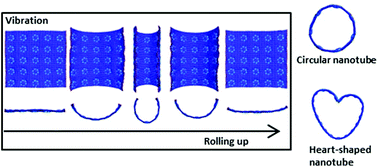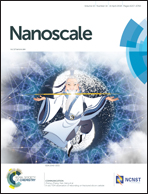Spontaneous rolling-up and assembly of graphene designed by using defects
Abstract
The inverse Stone–Wales defect is a typical defect in graphene, which causes local bumps and local deformation in graphene sheets. Our molecular dynamics simulations show that the spontaneous rolling up of graphene sheets can be induced by orderly distributed inverse Stone–Wales defect bumps, when defective graphene is cut into small strips. This spontaneous process is mainly dominated by the defect density and tailored graphene size. When the tailored length is longer than the upper threshold length, graphene sews up as a curly one-dimensional structure: heart-shaped nanotube. For medium length graphene (the length is in between the lower threshold value and upper threshold value), the results reveal that graphene finally curls into a completely or incompletely stitched nanotube similar to a cylindrical shell. This spontaneous process is produced by a high-frequency damped vibration accompanied by elastic and viscoelastic deformation in defective graphene. Thus, the properties of vibration are further investigated for graphene that has the tailored length shorter than the lower threshold length. This kind of graphene gradually forms a curved nanoribbon rather than a nanotube. It is also found that the bending rigidity of defective graphene is larger than that of pristine graphene.



 Please wait while we load your content...
Please wait while we load your content...